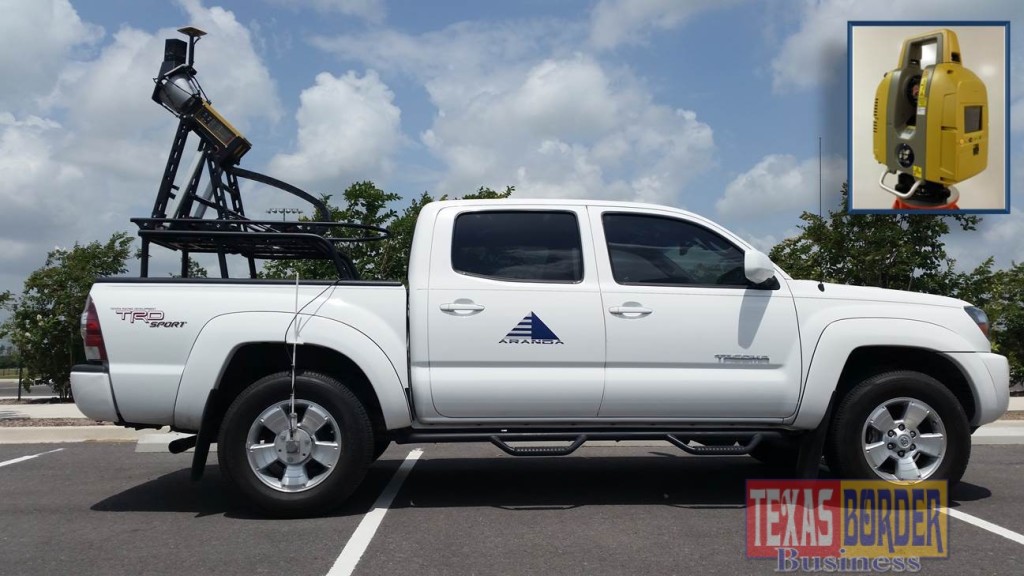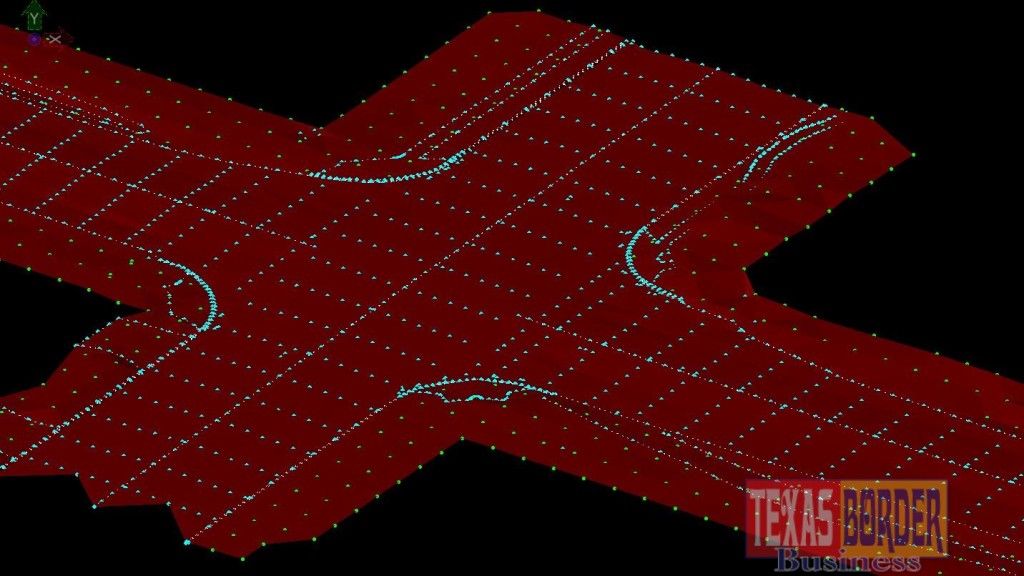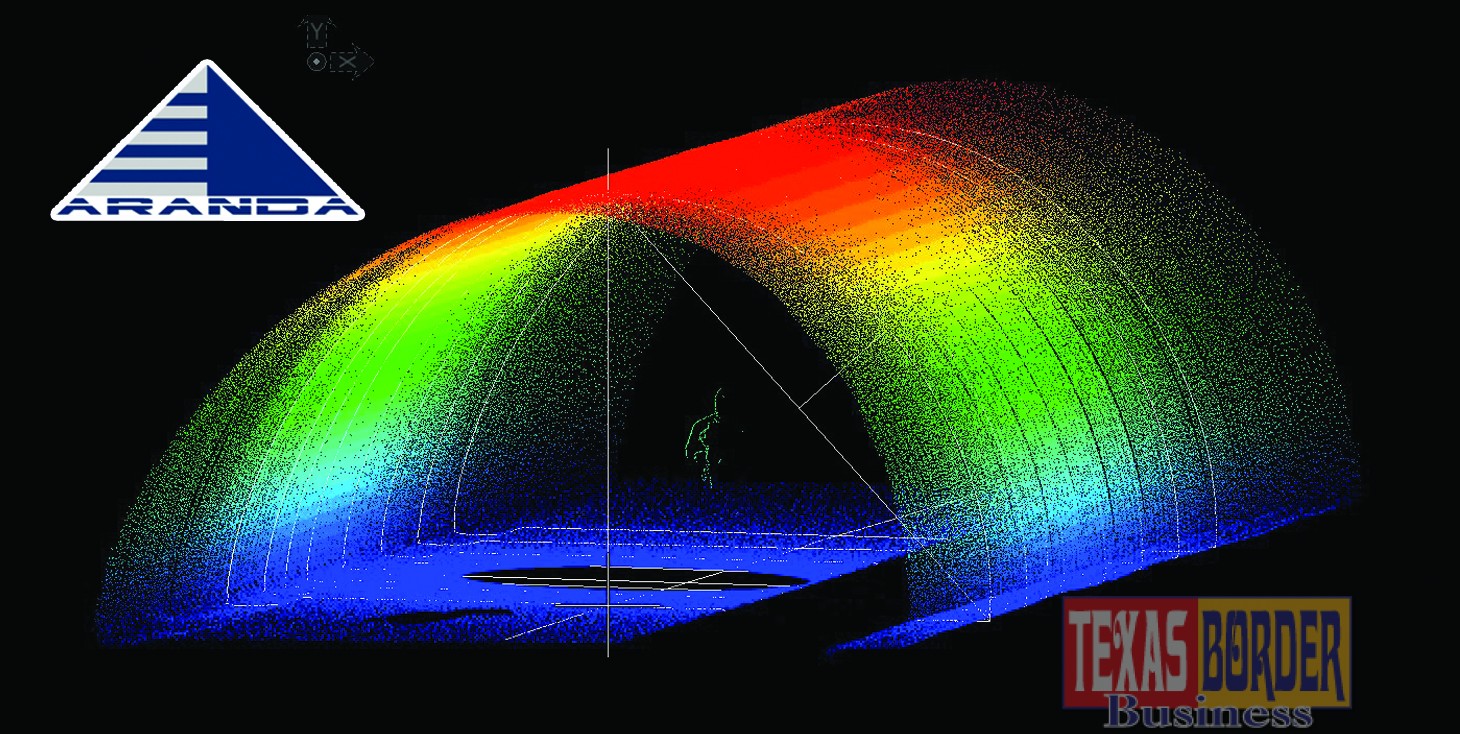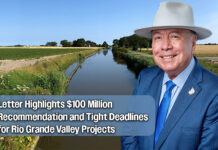By Christine “Chris” Ardis
As originally published by Texas Border Business newsprint edition.
For 26 years, the team at Aranda & Associates, Inc. of McAllen used traditional surveying tools and techniques to deliver surveys and a wide range of civil engineering products to their clients. But in late 2014, Aranda & Associates brought their new tech to town.
That new technology is LiDAR (Light Detection And Ranging), which uses lightning-quick lasers to measure the elevation not only of the topography but of anything above ground, such as vegetation (like trees and shrubs), buildings, utility poles and lines, bridges, and even playground equipment. While the scanner spins, the laser bounces to the earth and back to the scanner. A GPS (Global Positioning System) receiver and an IMU (Inertial Measurement Unit) calculate a precise position for each object scanned. Once the LiDAR terrain elevation data is collected, the LiDAR design and CADD (Computer-Aided Design and Drafting) specialists use the data to create point clouds, giving the client access to 3D models.
LiDAR is an active REMOTE sensing system, which translates to a much higher level of safety (for the surveying crew and for the general public) than found in traditional surveying. Another important benefit is precision.

“With the ability to acquire a million points per second,” said Jorge Gonzalez, professional engineer with Aranda & Associates, “we are now able to survey many more points compared to what we could achieve through traditional surveying methods.”
Rounding out the top three of the many benefits of using LiDAR is speed.
“LiDAR reduces field time by 70-80 percent,” said Tim Hruska, survey manager and LiDAR specialist with Aranda & Associates. As an added bonus, LiDAR can be used at any time of the day or night.
Aranda & Associates offers all three types of LiDAR: terrestrial, mobile, and aerial.
A terrestrial LiDAR scanner collects detailed data on individual sections of a project. For example, when scanning at a municipal water plant, data collected can be used to produce a 3D rendering of the entire plant, including the exact size and shape of the plant’s clarifiers, all of the pipes, and even the location and precise measurements of the stairs.
Mobile LiDAR is primarily used to survey streets and roadways, detecting anything visible to the naked eye. Aranda & Associates’ mobile scanner is mounted on a truck. When the crew is ready to begin collecting the data, a specially-mounted lift raises the scanner. As the scanner spins, it captures data at record speeds and with unparalleled precision.
Aerial LiDAR utilizes a scanner affixed to an airplane or helicopter to collect data over greater distances. City managers/planners and elected officials can use aerial imagery and LiDAR point clouds to analyze important topographic data when they are conducting long-range planning. Engineers use these data sets for major infrastructure projects. Aerial LiDAR is also used to record destruction following natural disasters, like floods and hurricanes, and to plan strategies for restoring a region.

(Photos courtesy of Tuck Mapping Solutions, Inc.)
Aranda & Associates, Inc. is the only surveying firm in the Rio Grande Valley to offer LiDAR surveying, and it took much more than purchasing the equipment to make the end product available to clients throughout the state. The Aranda team also had to undergo extensive training in data collection and in using a full range of software to create the 3D models and to deliver them in the format the client prefers. The team accepted the challenge, adapting quickly and enthusiastically to this new tech in town.
The City of Weslaco hired Aranda & Associates to use their new LiDAR technology to survey the Mayor Pablo G. Peña City Park, which is on the same site as the Weslaco Boys’ and Girls’ Club (currently under construction).
“We prefer to use our local surveyors and engineers,” said Mardoqueo Hinojosa, Weslaco’s city engineer, “and Aranda was able to get the work done fast. They surveyed a significant portion of the park, and we received the results in a very timely manner.”

There are countless applications for terrestrial, mobile, and aerial mapping. Here are a few examples:
Urban Planning: LiDAR data can be used to create Digital City Models in 3D.
Transportation: Corridor mapping is quicker, more detailed, and more precise when data is collected with LiDAR.
Oil and Gas Industry: LiDAR surveys provide the industry with 3D topographic models of the region where oil and gas are to be explored or of existing sites, showing the current facility inventory.
Fiber Optic Routes: Aranda & Associates has surveyed a proposed fiber optic route for the City of McAllen.
Electric Companies: Electric companies use LiDAR surveying for such deliverables as transmission line location and mapping, realignment surveys, right-of-way monument location, and recombination surveys. LiDAR surveying can also show the “sag” of the line to ensure clearance.
Irrigation Districts: LiDAR can be used not only to provide detailed data on the current topography of the district but also for planning future improvements
School Districts: When renovating current district facilities, LiDAR can be used to provide detailed data about the current interior and exterior of the facilities. When building new facilities, LiDAR surveying provides all of the information needed about surrounding structures, topography, and vegetation.
Architects: For the renovation of existing buildings, architects can use the 3D models crafted from LiDAR data for precise information on all visible structural assets. When designing new buildings, LiDAR data is used to create 3D models depicting precise as-builts of all structural assets.
Coastline Management: LiDAR scans taken over a specified period of time allow various entities to detect and evaluate coastal erosion and to make accurate predictions about flood-prone areas.
Crime Scene Investigation: Surveying firms are now being hired to use LiDAR equipment at crime and accident scenes because detailed data can be gathered much quicker than when it is collected through traditional methods, allowing a scene to be cleared in significantly less time. Data is recorded and can be preserved for future use by investigators and/or the courts. Then, at any point in time, the scene can be re-visited, virtually, in 3D.

One local firm with whom Aranda & Associates has teamed up to perform LiDAR surveying is TEDSI Infrastructure Group. TEDSI works primarily on roadway and drainage projects, and the company has been extremely impressed with Aranda’s deliverables.
“The amount of data you’re getting, thousands of points with one pass, is far greater than with traditional surveying,” said Mark Corbitt, a professional engineer with TEDSI.
Aranda has completed several LiDAR surveying projects with TEDSI, including the Mayor Pablo G. Peña City Park, a roadway and a detention pond in Weslaco, and a topo (topographic map) of Owassa Road in Pharr.
According to Robert Fina, another professional engineer with TEDSI, “The LiDAR gives us more information, more details, and more accuracy for our designs.”
Corbitt said TEDSI definitely plans to work with Aranda on more projects incorporating their LiDAR equipment.
Aranda & Associates was also contracted to determine the structural integrity of some irrigation bridges in the area (as seen on the front cover). The Aranda team used their terrestrial LiDAR equipment to collect data. The data was then geo-referenced to meet any coordinate system and any datum (elevation), as needed. The LiDAR and CADD specialists created a baseline and measured the distance between the baseline and various points throughout the bridges. Models were then created in 3D showing the measurements at each interval.
The Aranda & Associates team welcomes the opportunity to meet with you to discuss how you can use LiDAR in your industry. While their office is located in McAllen, they serve the Rio Grande Valley and the entire state of Texas. You can visit their web site at www.arandaandassociates.com and call Tony Aguirre or Jaime Aranda at 956-631-0944. They would love to show you the new tech in town.
This article was written by Christine “Chris” Ardis, she offers Freelance Writing and Consulting Services as a professional and now a Texas Border Business Guest Writer. TBB





















